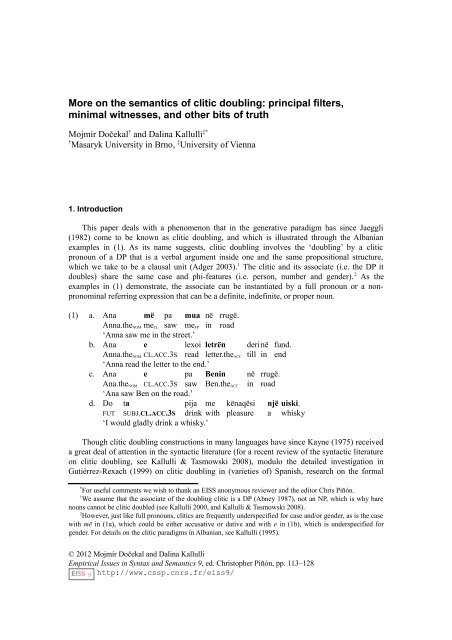Empirical Issues in Syntax and Semantics 9 (EISS 9 ... - CSSP - CNRS
Empirical Issues in Syntax and Semantics 9 (EISS 9 ... - CSSP - CNRS
Empirical Issues in Syntax and Semantics 9 (EISS 9 ... - CSSP - CNRS
You also want an ePaper? Increase the reach of your titles
YUMPU automatically turns print PDFs into web optimized ePapers that Google loves.
More on the semantics of clitic doubl<strong>in</strong>g: pr<strong>in</strong>cipal filters,<br />
m<strong>in</strong>imal witnesses, <strong>and</strong> other bits of truth<br />
Mojmír Dočekal † <strong>and</strong> Dal<strong>in</strong>a Kallulli ‡*<br />
†<br />
Masaryk University <strong>in</strong> Brno, ‡ University of Vienna<br />
1. Introduction<br />
This paper deals with a phenomenon that <strong>in</strong> the generative paradigm has s<strong>in</strong>ce Jaeggli<br />
(1982) come to be known as clitic doubl<strong>in</strong>g, <strong>and</strong> which is illustrated through the Albanian<br />
examples <strong>in</strong> (1). As its name suggests, clitic doubl<strong>in</strong>g <strong>in</strong>volves the ‘doubl<strong>in</strong>g’ by a clitic<br />
pronoun of a DP that is a verbal argument <strong>in</strong>side one <strong>and</strong> the same propositional structure,<br />
which we take to be a clausal unit (Adger 2003). 1 The clitic <strong>and</strong> its associate (i.e. the DP it<br />
doubles) share the same case <strong>and</strong> phi-features (i.e. person, number <strong>and</strong> gender). 2 As the<br />
examples <strong>in</strong> (1) demonstrate, the associate can be <strong>in</strong>stantiated by a full pronoun or a nonpronom<strong>in</strong>al<br />
referr<strong>in</strong>g expression that can be a def<strong>in</strong>ite, <strong>in</strong>def<strong>in</strong>ite, or proper noun.<br />
(1) a. Ana më pa mua në rrugë.<br />
Anna.the NOM me CL saw me FP <strong>in</strong> road<br />
‘Anna saw me <strong>in</strong> the street.’<br />
b. Ana e lexoi letrën der<strong>in</strong>ë fund.<br />
Anna.the NOM CL.ACC.3S read letter.the ACC till <strong>in</strong> end<br />
‘Anna read the letter to the end.’<br />
c. Ana e pa Ben<strong>in</strong> në rrugë.<br />
Ana.the NOM CL.ACC.3S saw Ben.the ACC <strong>in</strong> road<br />
‘Ana saw Ben on the road.’<br />
d. Do ta pija me kënaqësi një uiski.<br />
FUT SUBJ.CL.ACC.3S dr<strong>in</strong>k with pleasure a whisky<br />
‘I would gladly dr<strong>in</strong>k a whisky.’<br />
Though clitic doubl<strong>in</strong>g constructions <strong>in</strong> many languages have s<strong>in</strong>ce Kayne (1975) received<br />
a great deal of attention <strong>in</strong> the syntactic literature (for a recent review of the syntactic literature<br />
on clitic doubl<strong>in</strong>g, see Kallulli & Tasmowski 2008), modulo the detailed <strong>in</strong>vestigation <strong>in</strong><br />
Gutiérrez-Rexach (1999) on clitic doubl<strong>in</strong>g <strong>in</strong> (varieties of) Spanish, research on the formal<br />
*<br />
For useful comments we wish to thank an <strong>EISS</strong> anonymous reviewer <strong>and</strong> the editor Chris Piñón.<br />
1<br />
We assume that the associate of the doubl<strong>in</strong>g clitic is a DP (Abney 1987), not an NP, which is why bare<br />
nouns cannot be clitic doubled (see Kallulli 2000, <strong>and</strong> Kallulli & Tasmowski 2008).<br />
2<br />
However, just like full pronouns, clitics are frequently underspecified for case <strong>and</strong>/or gender, as is the case<br />
with më <strong>in</strong> (1a), which could be either accusative or dative <strong>and</strong> with e <strong>in</strong> (1b), which is underspecified for<br />
gender. For details on the clitic paradigms <strong>in</strong> Albanian, see Kallulli (1995).<br />
© 2012 Mojmír Dočekal <strong>and</strong> Dal<strong>in</strong>a Kallulli<br />
<strong>Empirical</strong> <strong>Issues</strong> <strong>in</strong> <strong>Syntax</strong> <strong>and</strong> <strong>Semantics</strong> 9, ed. Christopher Piñón, pp. 113–128<br />
http://www.cssp.cnrs.fr/eiss9/











